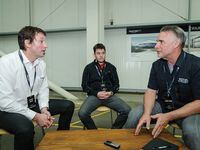Imagine that you're 19 or 20 and your father, having seen you drive your own million-mile beater without too much drama, absent any warning hands you the keys to his beloved Daytona Yellow Corvette. When your head clears and you can manage speech, you offer a weak, "Thanks, Dad," and begin wondering if you'll be able to get it down the driveway in one piece. You feel the weight of the responsibility upon you; his trust must not be broken. I can imagine Triumph's engineers feeling a little like this—tossed the keys to remaking the firm's most successful modern motorcycle, a nameplate that simultaneously embodies the best of Triumph's glory days and, if done right, ensures its future. The Bonneville.
I chatted briefly with Triumph’s Chief Engineer Stuart Wood during the press preview at the factory (see the whole story starting on page 34). For an engineer, he’s surprisingly “on about” the Bonnie’s styling. “Well, it’s better in every way, isn’t it?” Of course he would say that… “When you look at the new Bonnevilles you can see that the lines are more pure, much more authentic and faithful to the original bikes. When you see them finished, they look right. It’s obvious they look right, but the amount of effort to get there was massive.”
Part of the challenge was to package the bike in a way that kept styling pure but also allowed for modern conveniences like ABS and ride by wire, as well as sufficient cooling to permit tuning that meets the latest Euro 4 emissions regulations. With a roadster, there’s almost no place to hide the required hardware. And it’s especially difficult if you’re trying to make the new bike look more “airy” than the old one.
“Everybody wanted that nice, straight line in the exhaust [from the head to the muffler], which you struggle to package with a 650cc engine, let alone a 1200,” Wood says. “We have a profile similar to the old bikes but have, rather cleverly, managed to package in all the modern technology. We’re trying to make bikes that look good,” within the confines of the packaging, which means the Bonneville can’t get very large. It has to feel compact, it has to have a low seat, and it has to feel manageable. “Yet we were aware of the expectations in the marketplace, especially in America where a 900cc motorcycle is entry level.”
Wood brought up something interesting in our conversation I’d never considered. Triumph knew that performance was important to Bonneville customers, but it had to be a certain kind of performance. “With the new engine and our ride-by-wire system we can really make it easy to use, with an emphasis on torque,” he says, “but still with good performance. Some manufacturers place such an emphasis on heritage that they’re willing to sacrifice performance.” Or never move it forward at all, which is essentially Wood’s point. Perhaps it helps that the original Bonneville’s raison d’être was performance. It’s in no way inauthentic if it’s a reasonably quick motorcycle.
I asked Wood if the Bonnevilles were being planned as a long-life product, since the current bikes have been around for 15 seasons. “I would like to think so, yes,” he said then added, “After all, this is a solid part of our range that doesn’t demand frequent updates.” Indeed, for bikes that are often customized, rapid year-on-year changes in design are a hindrance; if the aftermarket has to play catch-up, its key players will go somewhere else. Triumph knows this all too well and so is loathe to upset the balance.
Wood also hinted at the future of the line. “I think we have opportunities to offer more from the Bonneville range,” he said. “There will be more exciting bikes.” And there he stopped, aware that a room full of Triumph staff and journalists would pounce on any mention of models beyond the 2016s.
At that moment, I got the distinct sense that Wood and his guys had a nice spin in the yellow Corvette, were happy to have it safely back in the garage, confidence bolstered, experiences logged, ready for the next assignment.












/cloudfront-us-east-1.images.arcpublishing.com/octane/IIGGWFOTOJGB7DB6DGBXCCMTDY.jpg)
/cloudfront-us-east-1.images.arcpublishing.com/octane/QSTCM6AVEZA5JJBUXNIQ3DSOF4.jpg)
/cloudfront-us-east-1.images.arcpublishing.com/octane/U4I7G625B5DMLF2DVIJDFZVV6M.jpg)
/cloudfront-us-east-1.images.arcpublishing.com/octane/B6XD6LS6IVCQPIU6HXDJSM3FHY.jpg)
/cloudfront-us-east-1.images.arcpublishing.com/octane/ICL63FEDDRDTTMINYICCEYGMDA.jpg)
/cloudfront-us-east-1.images.arcpublishing.com/octane/FCGZHQXRBZFLBAPC5SDIQLVF4I.jpg)
/cloudfront-us-east-1.images.arcpublishing.com/octane/WNOB6LDOIFFHJKPSVIWDYUGOPM.jpg)

/cloudfront-us-east-1.images.arcpublishing.com/octane/X33NU3E525ECRHXLNUJN2FTRKI.jpg)
/cloudfront-us-east-1.images.arcpublishing.com/octane/6KKT5NNL2JAVBOXMZYS5ZO76YA.jpg)
/cloudfront-us-east-1.images.arcpublishing.com/octane/J5RKG5O455GMPGQRF2OG6LRT7A.jpg)
/cloudfront-us-east-1.images.arcpublishing.com/octane/GX2CIZKQVRH2TATDM26KFG2DAE.jpg)
/cloudfront-us-east-1.images.arcpublishing.com/octane/ZWIDYSAKQZHD5BHREMQILXJCGM.jpg)
/cloudfront-us-east-1.images.arcpublishing.com/octane/CYUHJZCTSJCH3MRAQEIKXK7SCQ.jpg)
/cloudfront-us-east-1.images.arcpublishing.com/octane/LKOFINY56FCXJCANJ5M7ZDQUBY.jpg)
/cloudfront-us-east-1.images.arcpublishing.com/octane/4NBPDACMWJH63JQYJVK3QRBDZI.jpg)
/cloudfront-us-east-1.images.arcpublishing.com/octane/KKHQHRR3FJGX7H2IPU6RALMWG4.jpg)

/cloudfront-us-east-1.images.arcpublishing.com/octane/5IOFS5JAE5FOXMNA23ZRAVVYUU.jpg)
/cloudfront-us-east-1.images.arcpublishing.com/octane/CGXQ3O2VVJF7PGTYR3QICTLDLM.jpg)

/cloudfront-us-east-1.images.arcpublishing.com/octane/OQVCJOABCFC5NBEF2KIGRCV3XA.jpg)
/cloudfront-us-east-1.images.arcpublishing.com/octane/OPVQ7R4EFNCLRDPSQT4FBZCS2A.jpg)
/cloudfront-us-east-1.images.arcpublishing.com/octane/YBPFZBTAS5FJJBKOWC57QGEFDM.jpg)